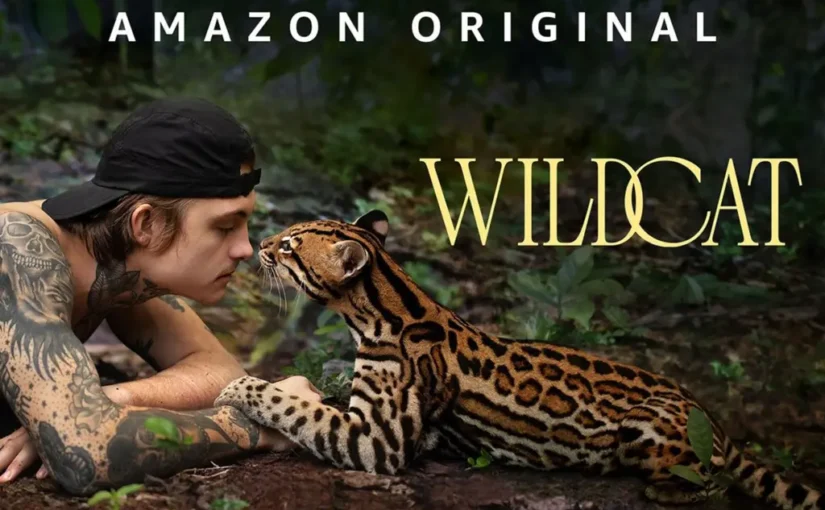Wildcat, a 2022 documentary directed by Trevor Frost and Melissa Lesh, is a deeply moving film that explores the intersection of human trauma, wildlife conservation, and the transformative power of connection. The film follows the story of Harry Turner, a young British veteran struggling with severe PTSD, as he embarks on a journey to the Peruvian Amazon to rehabilitate an orphaned ocelot named Keanu. What begins as a mission to save a wild animal becomes a profound exploration of healing, resilience, and the bonds that unite humans and nature.
At the heart of Wildcat is Harry Turner’s personal story, which serves as the emotional anchor of the film. After serving in Afghanistan, Harry returns home burdened by the psychological scars of war. Plagued by depression, anxiety, and a sense of purposelessness, he finds himself adrift, unable to reintegrate into civilian life. His journey to the Amazon is both an escape and a search for meaning, a desperate attempt to find solace in the wilderness.
The film does not shy away from depicting the raw and often painful realities of Harry’s mental health struggles. Through candid interviews and intimate footage, Wildcat portrays his moments of despair, his battles with self-doubt, and his ongoing quest for redemption. Harry’s vulnerability is palpable, making his journey all the more compelling and relatable. His story is a stark reminder of the invisible wounds carried by veterans and the challenges they face in finding peace after war.
The arrival of Keanu, a tiny orphaned ocelot, marks a turning point in Harry’s life. Tasked with raising and rehabilitating the wild cat, Harry finds a renewed sense of purpose. The bond that forms between man and animal is at the core of Wildcat, and the film beautifully captures the tenderness, patience, and dedication required to care for a wild creature. Through his interactions with Keanu, Harry begins to confront his own pain, finding moments of joy and connection that had long eluded him.
Keanu’s journey from a vulnerable cub to a confident, independent ocelot mirrors Harry’s own path toward healing. The film highlights the parallels between their experiences, emphasizing the transformative power of caregiving and the ways in which helping another being can lead to self-discovery and growth. Keanu becomes more than just a wild animal; he is a symbol of hope, resilience, and the possibility of renewal.
The Peruvian Amazon serves as both a sanctuary and a formidable challenge in Wildcat. The lush, untamed landscape is a character in its own right, offering a stark contrast to the structured, often oppressive environment of military life. For Harry, the Amazon represents a chance to start anew, to immerse himself in a world where survival depends on adaptability, patience, and respect for nature.
However, the jungle is not without its dangers. The film captures the physical and emotional toll of living in such a remote and demanding environment. From navigating treacherous terrain to facing the constant threat of predators, Harry’s journey is fraught with challenges. Yet, it is precisely these challenges that force him to confront his fears and insecurities, pushing him toward a deeper understanding of himself and his place in the world.
At its core, Wildcat is a story about connection—between humans and animals, between individuals and nature, and between past and present. The film underscores the importance of empathy, compassion, and the healing power of relationships. Through his bond with Keanu, Harry learns to forgive himself, to embrace vulnerability, and to find meaning in the act of caring for another being.
The documentary also raises important questions about conservation and the ethical complexities of human-wildlife interactions. While Harry’s efforts to rehabilitate Keanu are driven by genuine love and concern, the film does not gloss over the challenges of reintroducing a captive-raised animal into the wild. It prompts viewers to reflect on the responsibilities that come with intervening in the lives of wild creatures and the delicate balance required to protect both animals and their habitats.
Visually, Wildcat is a stunning achievement. The filmmakers capture the breathtaking beauty of the Amazon, from its dense forests to its vibrant wildlife, creating a vivid and immersive experience for the audience. The close-up shots of Keanu, with his striking spotted coat and expressive eyes, are particularly captivating, highlighting the ocelot’s unique charm and personality.
Emotionally, Wildcat is a powerful and deeply affecting film. It is a testament to the resilience of the human spirit and the transformative power of love and connection. Harry’s journey is one of redemption and hope, a reminder that even in the darkest moments, there is the potential for healing and renewal.
Wildcat is more than just a documentary about a man and an ocelot; it is a profound exploration of trauma, healing, and the bonds that unite us with the natural world. Through Harry Turner’s story, the film offers a poignant reminder of the importance of empathy, compassion, and the enduring power of connection. It is a cinematic triumph that resonates on both an emotional and philosophical level, leaving viewers with a renewed appreciation for the beauty and complexity of life. In the end, Wildcat is a celebration of resilience, redemption, and the transformative power of love—both for ourselves and for the world around us.
